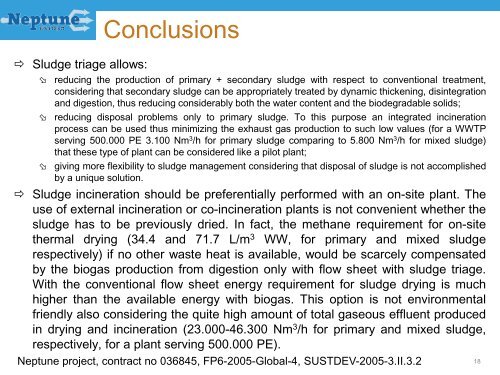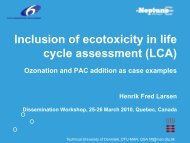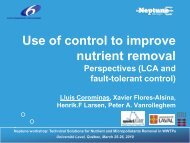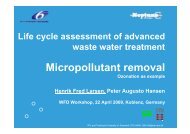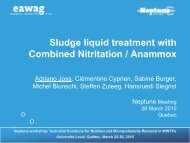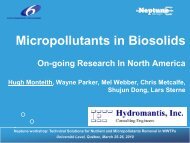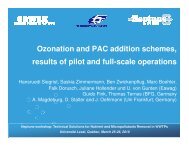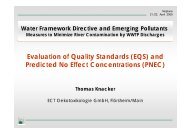Sustainable sludge handling - EU Project Neptune
Sustainable sludge handling - EU Project Neptune
Sustainable sludge handling - EU Project Neptune
You also want an ePaper? Increase the reach of your titles
YUMPU automatically turns print PDFs into web optimized ePapers that Google loves.
Sludge triage allows:<br />
<br />
<br />
<br />
Conclusions<br />
reducing the production of primary + secondary <strong>sludge</strong> with respect to conventional treatment,<br />
considering that secondary <strong>sludge</strong> can be appropriately treated by dynamic thickening, disintegration<br />
and digestion, thus reducing considerably both the water content and the biodegradable solids;<br />
reducing disposal problems only to primary <strong>sludge</strong>. To this purpose an integrated incineration<br />
process can be used thus minimizing the exhaust gas production to such low values (for a WWTP<br />
serving 500.000 PE 3.100 Nm 3 /h for primary <strong>sludge</strong> comparing to 5.800 Nm 3 /h for mixed <strong>sludge</strong>)<br />
that these type of plant can be considered like a pilot plant;<br />
giving more flexibility to <strong>sludge</strong> management considering that disposal of <strong>sludge</strong> is not accomplished<br />
by a unique solution.<br />
Sludge incineration should be preferentially performed with an on-site plant. The<br />
use of external incineration or co-incineration plants is not convenient whether the<br />
<strong>sludge</strong> has to be previously dried. In fact, the methane requirement for on-site<br />
thermal drying (34.4 and 71.7 L/m 3 WW, for primary and mixed <strong>sludge</strong><br />
respectively) if no other waste heat is available, would be scarcely compensated<br />
by the biogas production from digestion only with flow sheet with <strong>sludge</strong> triage.<br />
With the conventional flow sheet energy requirement for <strong>sludge</strong> drying is much<br />
higher than the available energy with biogas. This option is not environmental<br />
friendly also considering the quite high amount of total gaseous effluent produced<br />
in drying and incineration (23.000-46.300 Nm 3 /h for primary and mixed <strong>sludge</strong>,<br />
respectively, for a plant serving 500.000 PE).<br />
<strong>Neptune</strong> project, contract no 036845, FP6-2005-Global-4, SUSTDEV-2005-3.II.3.2 18


